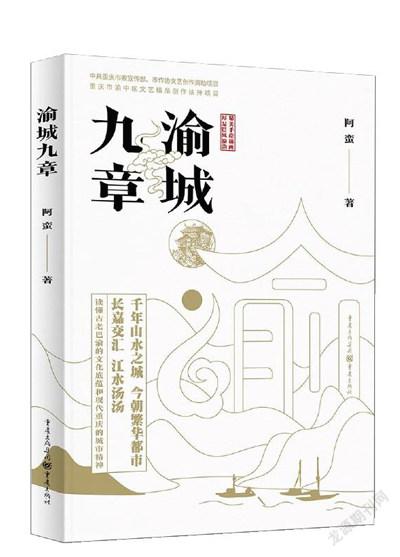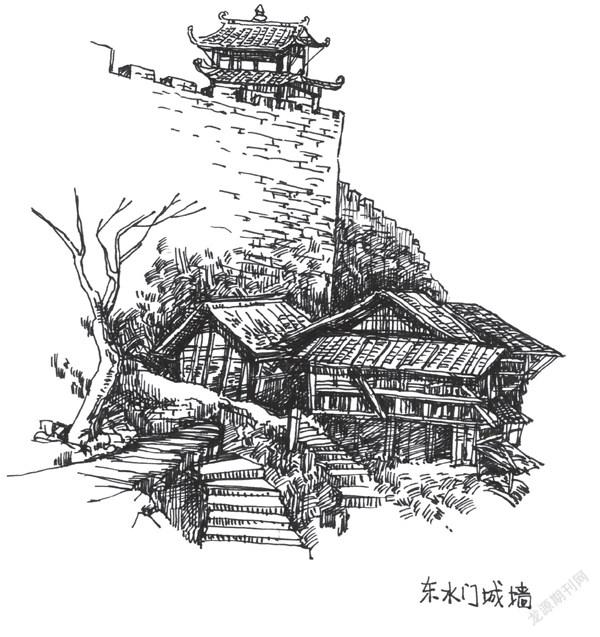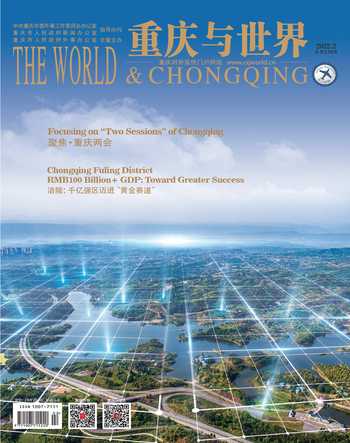跟着《渝城九章》寻踪重庆母城
杨艳



At the end of 2021, Toward a Modern Chongqing was published. It records great changes that Chongqing has gone through, from Jiangzhou and Yuzhou in the old times to the current Chongqing, and from Baixiang Road to Zhongshan 4th Road. As a key work by Chongqing Writers Association and Yuzhong Writers Association, the book analyzes the connotation of Bayu culture and the spirit of the city formed in the past 3,000 years. With the origin and development of Chongqing as the main line, it depicts the history of Ba people making Jiangzhou the capital city, four fortification projects, displacement of the city’s center, and modernization of Chongqing.
The relaxing words and pen paintings in the book outline the appearance of Yuzhong District, the root of modern Chongqing, in the old times, just like a vivid documentary that enables the readers to start a journey of tracing its humanistic history. According to the author Aman, “Yuzhong enjoys profound culture. Since I was born, lived and worked here, I want to restore the history of the city in my book based on my personal experience. Hopefully the readers can, after reading it, grasp the essence of the time-honored Bayu culture and the spirit of modern Chongqing.”
The book is rigorous, objective and unique in perspective. The narration of major historical events and figures are based on authoritative documents, field investigation and the author’s personal experience, thus free from subjective speculation or frivolousness. Major historical events in this book include: Ba Manzi’s protection of his city by offering his head, Zhao Yun’s supervision on Jiangzhou, the fortification project led by Li Yan, Yu Jie and Zhang Jue’s fight against Mongolia, Jian Yi and Zou Jin’s choices in Jianwen Incident, the Great Xia Kingdom established by Ming Yuzhen, Wang Erjian’s compilation of Archives of Ba County, etc. In addition, the book also analyzes the role played by migrants and modern merchants in Chongqing’s development, and tells stories of important figures in modern and contemporary times.
The book recalls the growing experience and memories shared by Chongqing people in Aman’s generation. For example, there is a paragraph about the two rivers:
Living by the Yangtze River and the Jialing River for thousands of years, people in this land have formed a lifestyle that is close to water. Some recreational activities derived from the rivers are exclusive to Chongqing. They have been preserved till today and become attractive and proud traditions for local people. For example, there is a traditional entertainment activity called “fangtan”. It means to swim from somewhere in the upper reaches of the river to the lower reaches along with the currents. It not only saves time and energy, but is also enjoyable. It feels totally different when you swim in the Yangtze River and the Jialing River. As Jialing River is not wide, most of the time, the currents are gentle and people get rather close to the shores. Flowing downward from Niujiaotuo to Chaotianmen, you will pass by Zengjiayan, Daxigou, Huanghuayuan, No.1 Bridge, Linjiangmen, Hongyadong, and Qiansimen Bridge, as if rambling through a gallery of Chongqing’s landscape. While enjoying the scenery, an hour and a half would pass quickly.
The book condenses Chongqing’s culture, geographic features and history into eight main chapters, namely “A Blessed Land”, “General Zhao Yun’s Tent Headquarter and the Twin Stones in Chaotianmen”, “Fortification in Ancient Chongqing and the History of Dongshui Gate”, etc. In a story telling manner, it makes an all-round introduction of Yuzhong District with its history as the principal line, and demonstrates the latest historical and cultural discoveries in recent years.
In the form of cultural prose, Toward A Modern Chongqing rearranges historical materials and literature that are once obscure into a more reader-friendly narration. For example, the book quotes a ballad called A Pray for Rain by Wang Erjian, an official in Ba County during the Qing Dynasty:
Ba people pray to the Heaven: rain pearls or rain jade, might as well rain grains; grains from the Heaven are too sacred to eat, so a downpour or snow may just make it; with raindrops and snow, the crops can grow; it’s much better than rain jade or pearl.
Aman wrote about his understanding of it:
I didn’t translate this ballad word-by-word, because I was extremely amazed by its wording. In this ballad, the Chinese character “雨” is used nine times as the verb “rain”, and twice as the noun “rain”. It delivers such a great impulsion, just like nine fists waving towards the sky, trying to knock the two raindrops down from the Heaven.
When he was working in the Cultural Center of Yuzhong District, Chongqing, the author made a thorough field investigation of Chongqing’s city wall and traced the arduous journey of the Ba people along rivers and mountains. He also carried out meticulous research and source tracing when he discovered mistakes in historical records. For example, Archives of Ba County: Governance of A City writes that Chaotian Gate, Nanji Gate and Taiping Gate, among others, were all demolished. This disagrees with the results of Aman’s field visits and the national cultural relics survey. Therefore, the 5th chapter – “The Palace of Ming Yuzhen and the Fortification Project by Commander Dai Ding” points out the discrepancy, providing convincing reference for the study and research on Chongqing’s history.
Painting/Zhuzijiang Photo/Aman
從江州、渝州到重庆,从白象街到中山四路……2021年末,新书《渝城九章》顺利出版。该书作为重庆市作协、渝中区作协重点作品,以重庆三千年城市史为背景,以重庆母城的确立、发展为主线,以巴人都江州、四次筑城、城市中心位移、走向现代化为节点,聚焦解析巴渝文化内涵和城市文化精神。
书中轻松活泼的文字和钢笔画,勾勒出一幅幅渝中母城曾经的相貌,犹若一部鲜活的纪录片,让读者在阅读中开启一场渝中母城人文历史的寻踪之旅。该书作者阿蛮表示,“渝中母城的文化底蕴非常深厚,我出生、生活、工作在这里,我想根据自己的体验,在书中还原这座城市的历史,希望读者能从中读懂古老巴渝的文化底蕴和现代重庆的城市精神。”
该书严谨、客观,视角独到,对重大历史事件和人物的叙述,如巴蔓子献头护城、赵云督江州、李严筑大城、余玠—张珏抗蒙、蹇义—邹瑾在“建文之变”中的选择、明玉珍建大夏国、王尔鉴描城市文脉线、移民与近代渝商的贡献、现当代风云人物故事等,都以权威史籍记载、经典遗址考察及作者阿蛮亲身经历为据,避开了主观臆测与戏说的缺陷。
书中回忆了像阿蛮一代老重庆人的成长经历和共同回忆,如谈及两江:
长江、嘉陵江千百年来为人们养成的亲水生活方式,包括在其他任何城市都见不到的玩乐方法仍然保留下来,成为一种令人自豪和可供回味的传统。比如,有一种玩法叫“放滩”,就是从江水上游的某个地方下水,顺着江流“放”到下游,省时又省力,十分畅快。在长江放滩,跟在嘉陵江放滩,所得体验又截然不同。嘉陵江江面不宽,多数时候水流平缓,人与岸相对距离较近。从牛角沱到朝天门,边游边看夕阳下的曾家岩、大溪沟、黄花园、一号桥、临江门、洪崖洞、千厮门,仿佛走进山水画廊,慢慢欣赏,一个半小时很快就过去了。
书中从“上天赐予的福地”“赵云中军帐与朝天门灵石”“李严城大城与东水门往事”等八个方面切入,把人文、地理、历史有机地结合,娓娓道来,既提纲挈领地贯穿母城的前世今生,又宏观而全面地介绍了母城,并融入了近些年的历史文化新发现。
史籍文献在该书中褪去了陈腐之气,通过文化散文的形式娓娓道来。“巴之民,叩天公,雨我珠,雨我玉,不如雨我粟。天雨粟,不可食,不如雨雨与雨雪。雨雨雨雪粟不竭,胜似苍天雨珠雪。”作者在解读王尔鉴的《巴民望雨谣》时写到:
我没有完全按照字面意思来硬译这首独特的歌谣,因为在读到这些诗句时,我的心灵受到了极大震撼。其中九个“雨”字是动词,只有两个字是真正的“雨”,那力度就像九只拳头向天挥舞,要把天上那两滴雨砸下来。
作者曾在渝中区文化馆工作,实地考察过完整地母城城墙,沿着巴人逆舟楫水、翻山跋涉之路线做过田野调查。他在书中对正史上所出现的错误进行了勘正和溯本正源。第五章《大夏皇宫和戴鼎砌城中》,就结合了作者走访以及全国文物普查结果指出,民国《巴县志·治城》中所记载的“朝天、南纪、太平等门悉行撤废”失之偏颇,为专家、学者研究重庆历史提供了很好的参考。
插图/珠子酱 阿蛮提供

